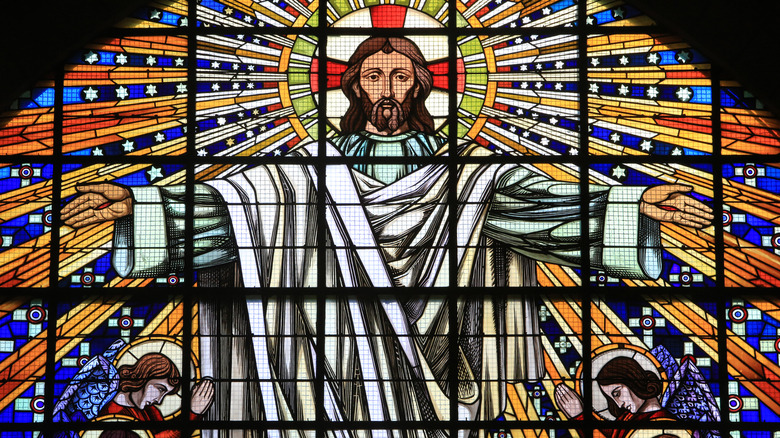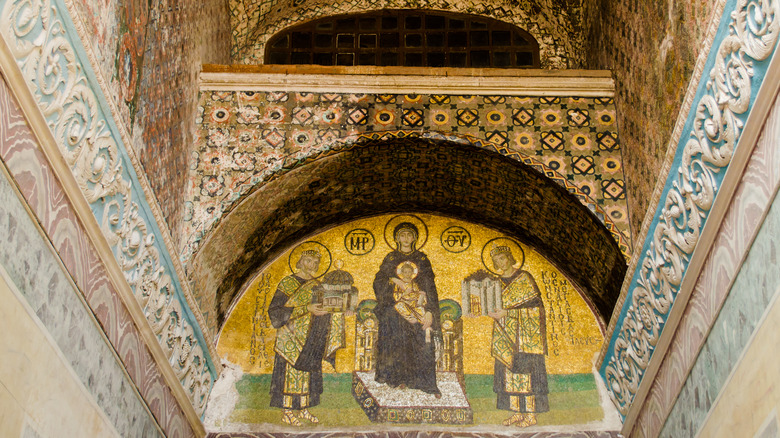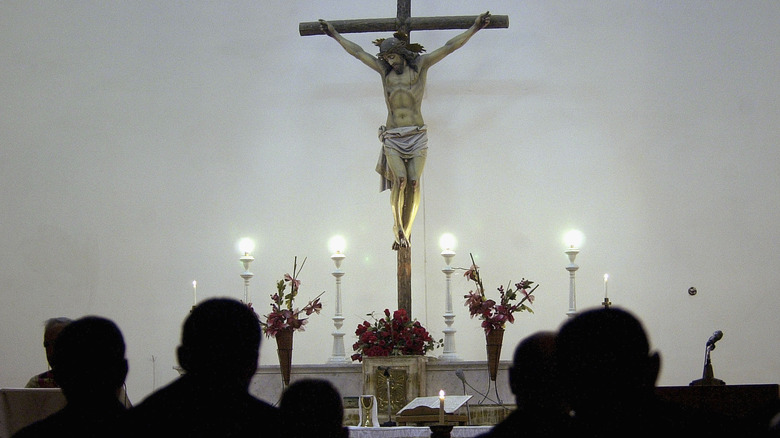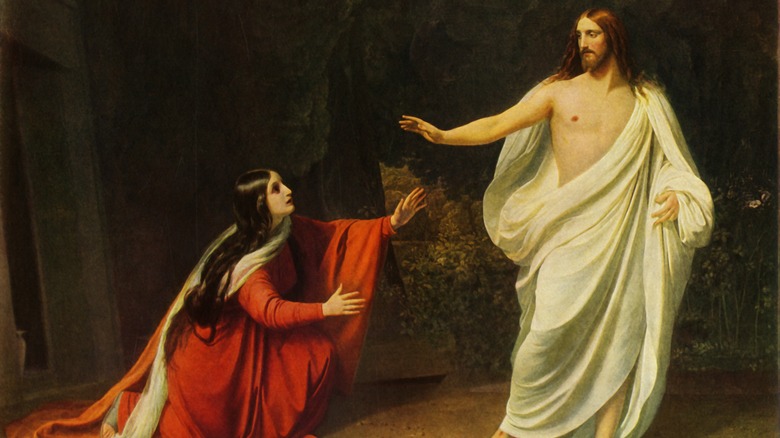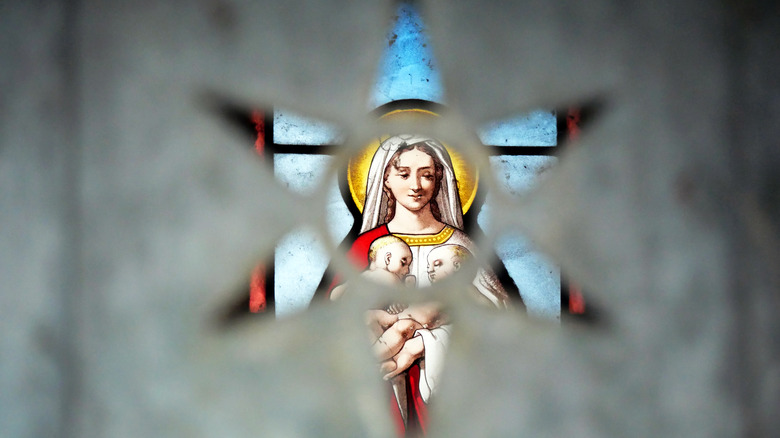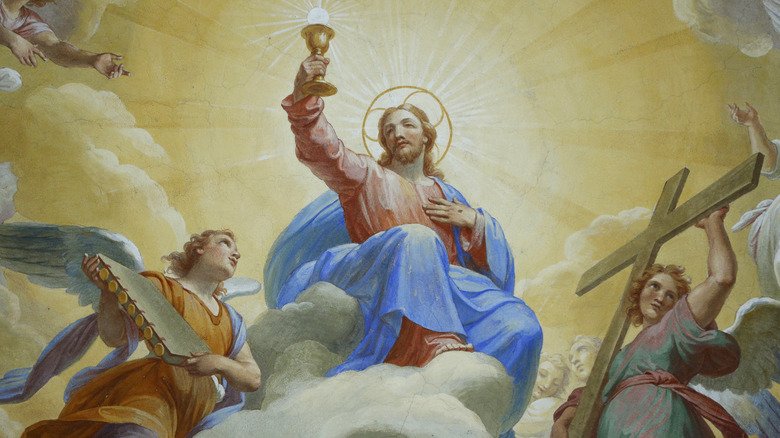The Secret Teachings Of Jesus Explained
At this point, it's pretty widely known that the books we've got in the Christian Bible weren't the only options available. The standard Catholic Bible has 73 books, including 45 in the Old Testament inherited from Christianity's Jewish roots, and 27 in the New Testament. The Protestant Reformation saw seven books removed, making the standard Protestant Bible 66 books long. It took almost 400 years of councils, sectarian division, so-called heretical groups, and more for the original Bible to come together about 400 C.E. But of course, it omitted quite a lot of potential writings — including supposed quotes from Jesus himself.
Amongst the loads and loads of religious texts that didn't make the officially sanctioned biblical cut, we've got the Old Testament Apocrypha, the New Testament Apocrypha including non-canonical Gnostic Gospels, numerous books of unknown authorship from the Pseudepigrapha, and much more. They were written in various languages like Greek, Latin, Hebrew, and Aramaic across hundreds of years. They also came from various locations across early Christendom like the caves west of the Dead Sea that yielded the Dead Sea Scrolls found from 1947 to 1956. Some texts, like the Gospel of Judas, have reached high-profile status because their stories potentially upend traditionally held doctrine.
Jesus himself — the reason that the Christian Bible exists — shows up fairly often in non-canonical books. Sometimes he's pontificating spiritual teachings, sometimes he's describing the creation of the cosmos, and sometimes he's even disclosing secret knowledge to Mary Magdalene.
The Sophia of Jesus
Before going further, bear in mind that this article exists to discuss "secret" teachings of Jesus described in unconventional ancient texts, not to perpetuate or subvert accepted theology. Belief belongs in the hands of the reader.
To start, we could do worse than "The Sophia of Jesus Christ" — aka, "The Wisdom of Jesus Christ." The book recounts one, longish conversation between Jesus and his most devout followers — 12 disciples and seven unnamed women — that takes place following Jesus' crucifixion and after he comes back to life. Jesus' followers grill him about the "underlying reality of the universe and the plan," the "invisible spirit," and why Jesus looks like he has a body made of light. What ensues is a profoundly weird conversation replete with undefined mystical terminology that echoes the kind of esotericism found in Old Testament apocryphal books like the Wisdom of Solomon.
Talking about himself in the third person, Jesus says that, "he embraces the whole of the totalities, while nothing embraces him. For he is all mind." Regarding his origins, Jesus says that the "Son of Man consented with Sophia, his consort, and revealed a great androgynous light. His male name is designated 'Savior, Begetter of All Things'. His female name is designated 'All-Begettress Sophia'. Some call her 'Pistis'." In discussing the creation of the universe and the nature of God, Jesus throws in terms like "Arch-Begetter, who is called 'Yaldabaoth'," "Assembly of the Eighth," "Self-perfected Mind," "First Existent Unbegotten Father," and more.
The Gospel of Thomas
Because the books of the canonical New Testament represent a highly curated vision of Jesus and the early Christian church, many of Jesus' non-canonical teachings come across as bizarre — like in "The Sophia of Jesus Christ." On the other hand, certain teachings are recognizable and even echo canonical biblical passages. This is the case with the "Gospel of Thomas," a very quotable book divided into "sayings" of Jesus like standalone micro-lessons.
Saying 16, for instance, reads, "Maybe people think that I've come to cast peace on the world, and they don't know that I've come to cast divisions on the earth: fire, sword, and war." Christians will recognize these lines from Matthew 10: "Do not suppose that I have come to bring peace to the earth. I did not come to bring peace, but a sword." Similarly, Saying 20 describes the famed mustard seed parable found in Matthew 13, comparing the kingdom of heaven to a mustard seed that shelters birds in its branches. Saying 54 even contains the "Blessed are the poor" beatitude. There are many more examples like this.
At the same time, the Gospel of Thomas contains some head-scratching stuff. In Saying 56 Jesus calls the world "a corpse," and in Saying 36 he advises not worrying too much about your clothes. Some of Jesus' teachings seem vague or self-evident, like Saying 58's, "Blessed is the person who's gone to a lot of trouble." Yet other parts sound like dime-store spiritual guru quotes, like Saying 67's, "Whoever knows everything, but is personally lacking, lacks everything."
The Gospel of Mary Magdalene
Despite the name of the book, Mary Magdalene doesn't feature prominently in "The Gospel of Mary Magdalene" — at least not until the end. Rather, the book consists of Mary quoting teachings that Jesus told her and no one else, largely the same kind of mystical musings about the nature of God and the cosmos that we've already encountered. This book does not contain some of the more juicy innuendo that's cropped up over the years about Jesus and Mary Magdalene being married, having sex, etc.
In the book, Mary states that Jesus said that "the All is being dissolved," and described a soul overcoming "the third power" and seeing "the fourth power." That fourth power took seven forms of "darkness," "desire," "ignorance," "the excitement of death," "the kingdom of the flesh," "the foolish wisdom of flesh," and "the wrathful wisdom." These powers call the aforementioned soul the "slayer of men" and "conqueror of space." Ultimately, it's revealed that Jesus was describing his own creation. "In an aeon I was released from a world," he concluded, "and in a Type from a type, and from the fetter of oblivion which is transient."
In the end, Jesus' follower Peter misses the point and instead grumbles about Jesus delivering private teachings to Mary and not the rest of them. Levi chastises him for being "hot-tempered" and says, "If the Savior made her worthy, who are you indeed to reject her?" That's pretty much where the book ends.
The Gospel of Philip
The "Gospel of Philip" is a weird one. It's got some of the same, repetitive, mystical talk of the kingdom of heaven, the cosmos, etc., as the rest of the writings described in this article. But, it differs because the writer provides a lot of non-quoted commentary about Christian belief and things that Jesus said and did. It's also separated by themes into sections like, "Father, Son, and Holy Spirit," "Becoming Christians," or "Overcoming the World." All in all, it reads like an early attempt at pedagogy mixed with Christian self-help literature.
Much of what the Gospel of Philip relates about Jesus' teachings and actions comes across as straight-up bizarre to a religion now 2,000 years in the making. Granted, it's got some of the same material we read in the canonical Bible, like Jesus saying, "Whoever doesn't eat my flesh and drink my blood doesn't have life in them" — a near copy-paste job from John 6. But it also says stuff like, "Truth is the Mother, but knowledge is the joining. Those who aren't given to sin are called 'free' by the world." Regarding people talking about Jesus' immaculate conception via the Holy Spirit, it reads, "They're wrong; they don't know what they're saying. When did a woman ever conceive by a woman?" It also contains typical riddle-like sayings from Jesus such as, "Blessed is the one who exists before existing, because they who exist did exist, and will exist."
The Secret Book of James
While there are plenty more writings to choose from when discussing the "secret" teachings of Jesus, we might as well end on "The Secret Book of James." Judging by the opening of this book — "you asked me to send you a secret book revealed to Peter and me" — it stands to reason that the writer claims to be James the apostle. The opening also mentions a previous book of secret teachings sent 10 months prior.
"The Secret Book of James" starts with Jesus urging his disciples to take the lead regarding their own salvation, saying, "Be eager to be saved without being urged. Rather, be ready on your own." He uses an extended alcohol analogy to explain his position, saying, "Don't you want to be filled? Your hearts are drunk. Don't you, then, want to be sober?" This analogy contains some of the same logic salad we've seen already, like, "So just as it's good for you to be lacking and bad for you to be full, whoever is full is also lacking. One who's lacking isn't filled the same way that someone who's lacking is filled."
Later, Jesus urges his disciples to remember his parables, like, "The Lamps of the Young Women" and "The Wage of the Workers." Ultimately, he criticizes them for being hypocrites, and they criticize Jesus for his hot-cold, unpredictable behavior. The book ends with Jesus going to Heaven and his followers seeing a vision of a "cacophony of wars and a trumpet blare and a great commotion."
